Nursing considerations for Valsartan and Eprex injection in chronic renal failure patient
VerifiedAdded on 2022/11/19
|7
|1564
|304
AI Summary
This article discusses the nursing considerations for Valsartan and Eprex injection in chronic renal failure patient. It also explains the use of teach-back method in patient education to improve patient satisfaction.
Contribute Materials
Your contribution can guide someone’s learning journey. Share your
documents today.
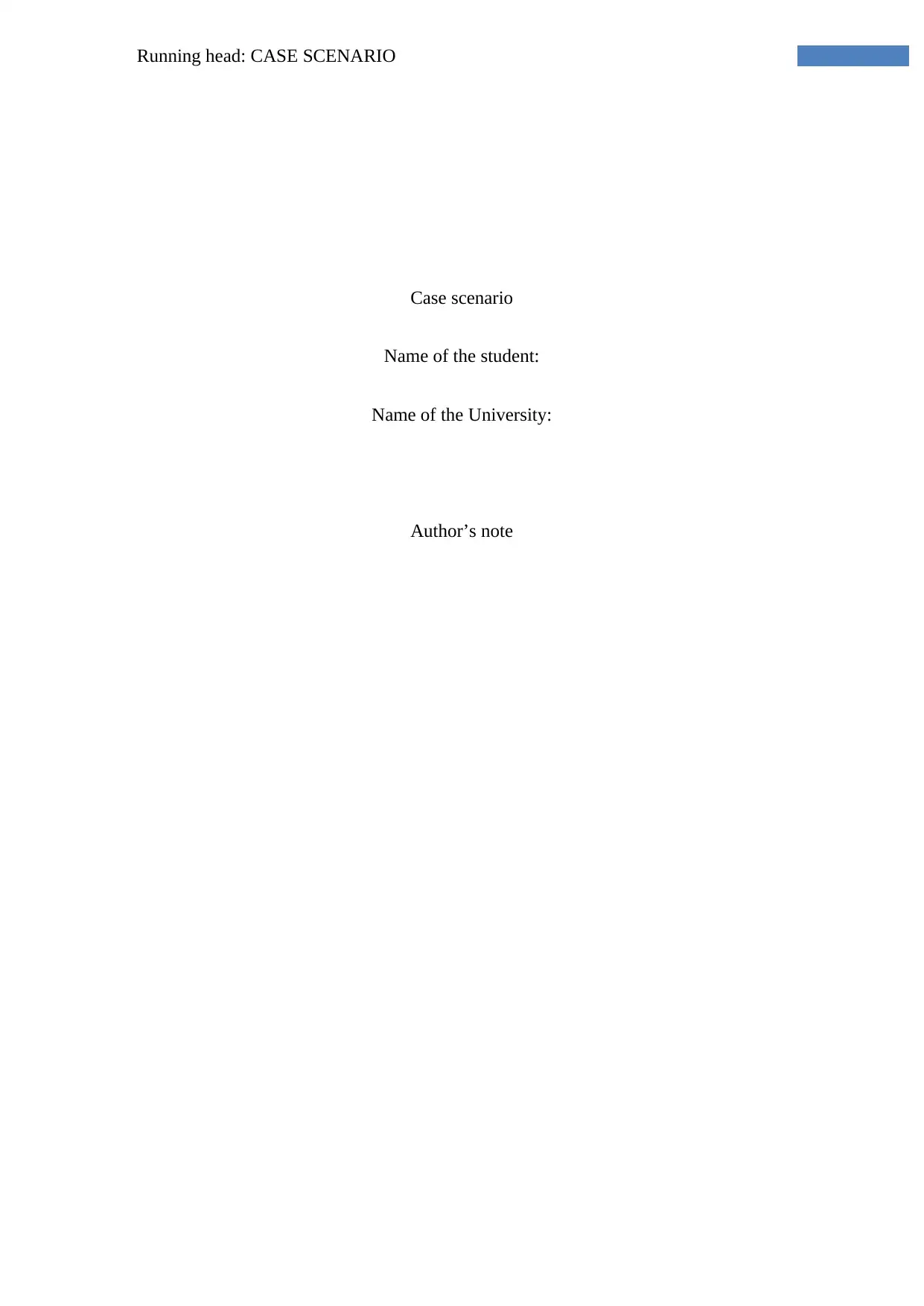
Running head: CASE SCENARIO
Case scenario
Name of the student:
Name of the University:
Author’s note
Case scenario
Name of the student:
Name of the University:
Author’s note
Secure Best Marks with AI Grader
Need help grading? Try our AI Grader for instant feedback on your assignments.
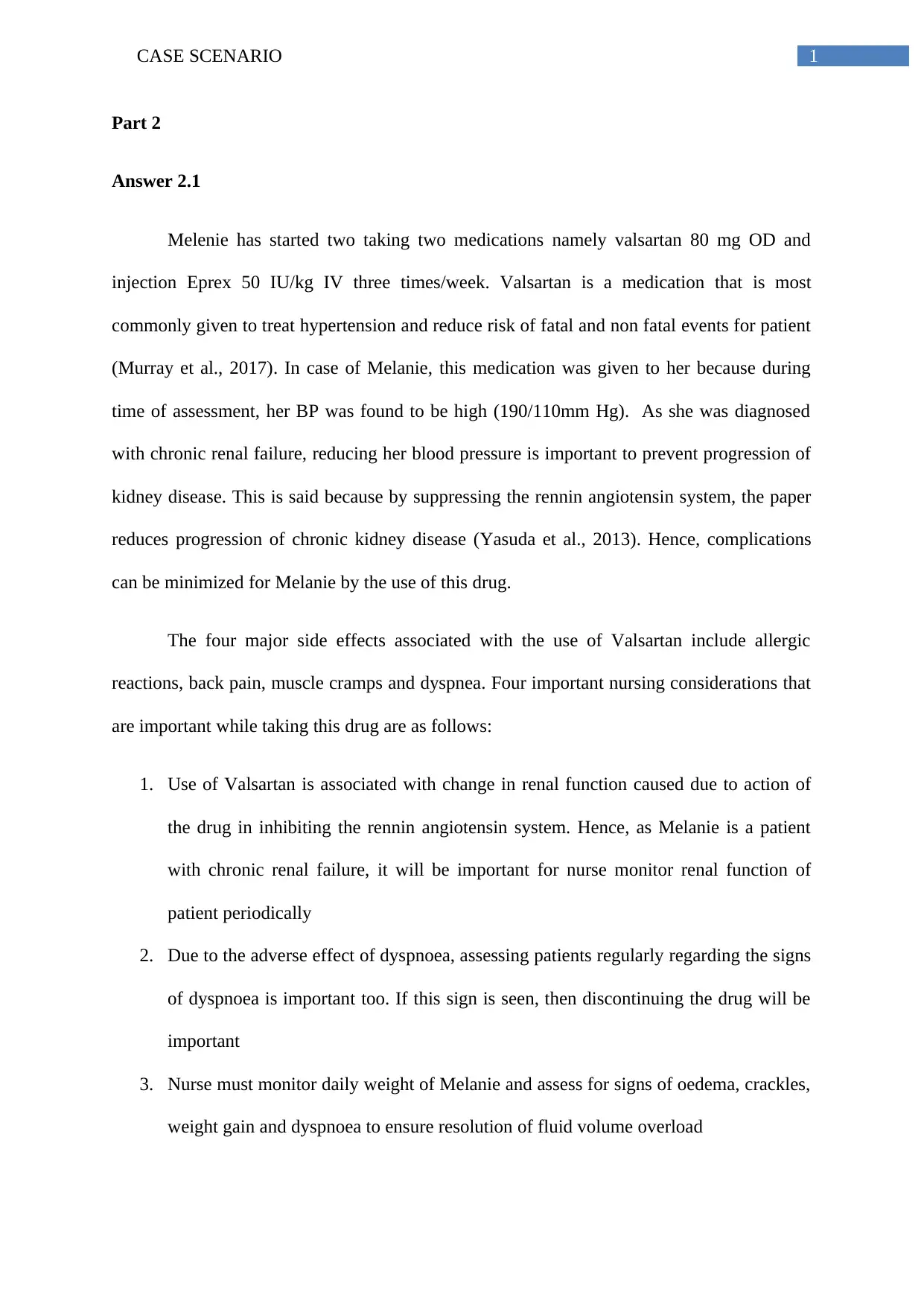
1CASE SCENARIO
Part 2
Answer 2.1
Melenie has started two taking two medications namely valsartan 80 mg OD and
injection Eprex 50 IU/kg IV three times/week. Valsartan is a medication that is most
commonly given to treat hypertension and reduce risk of fatal and non fatal events for patient
(Murray et al., 2017). In case of Melanie, this medication was given to her because during
time of assessment, her BP was found to be high (190/110mm Hg). As she was diagnosed
with chronic renal failure, reducing her blood pressure is important to prevent progression of
kidney disease. This is said because by suppressing the rennin angiotensin system, the paper
reduces progression of chronic kidney disease (Yasuda et al., 2013). Hence, complications
can be minimized for Melanie by the use of this drug.
The four major side effects associated with the use of Valsartan include allergic
reactions, back pain, muscle cramps and dyspnea. Four important nursing considerations that
are important while taking this drug are as follows:
1. Use of Valsartan is associated with change in renal function caused due to action of
the drug in inhibiting the rennin angiotensin system. Hence, as Melanie is a patient
with chronic renal failure, it will be important for nurse monitor renal function of
patient periodically
2. Due to the adverse effect of dyspnoea, assessing patients regularly regarding the signs
of dyspnoea is important too. If this sign is seen, then discontinuing the drug will be
important
3. Nurse must monitor daily weight of Melanie and assess for signs of oedema, crackles,
weight gain and dyspnoea to ensure resolution of fluid volume overload
Part 2
Answer 2.1
Melenie has started two taking two medications namely valsartan 80 mg OD and
injection Eprex 50 IU/kg IV three times/week. Valsartan is a medication that is most
commonly given to treat hypertension and reduce risk of fatal and non fatal events for patient
(Murray et al., 2017). In case of Melanie, this medication was given to her because during
time of assessment, her BP was found to be high (190/110mm Hg). As she was diagnosed
with chronic renal failure, reducing her blood pressure is important to prevent progression of
kidney disease. This is said because by suppressing the rennin angiotensin system, the paper
reduces progression of chronic kidney disease (Yasuda et al., 2013). Hence, complications
can be minimized for Melanie by the use of this drug.
The four major side effects associated with the use of Valsartan include allergic
reactions, back pain, muscle cramps and dyspnea. Four important nursing considerations that
are important while taking this drug are as follows:
1. Use of Valsartan is associated with change in renal function caused due to action of
the drug in inhibiting the rennin angiotensin system. Hence, as Melanie is a patient
with chronic renal failure, it will be important for nurse monitor renal function of
patient periodically
2. Due to the adverse effect of dyspnoea, assessing patients regularly regarding the signs
of dyspnoea is important too. If this sign is seen, then discontinuing the drug will be
important
3. Nurse must monitor daily weight of Melanie and assess for signs of oedema, crackles,
weight gain and dyspnoea to ensure resolution of fluid volume overload
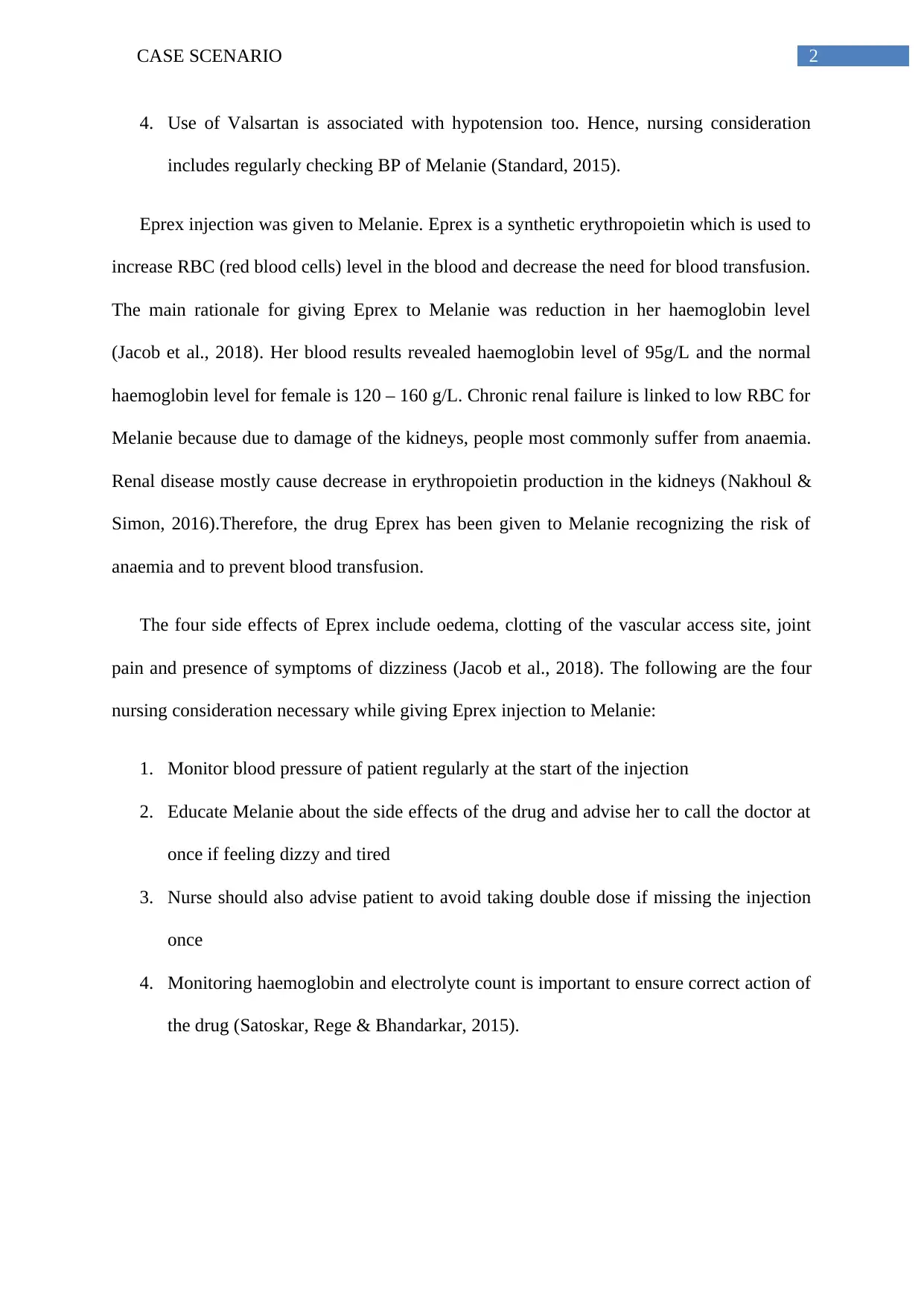
2CASE SCENARIO
4. Use of Valsartan is associated with hypotension too. Hence, nursing consideration
includes regularly checking BP of Melanie (Standard, 2015).
Eprex injection was given to Melanie. Eprex is a synthetic erythropoietin which is used to
increase RBC (red blood cells) level in the blood and decrease the need for blood transfusion.
The main rationale for giving Eprex to Melanie was reduction in her haemoglobin level
(Jacob et al., 2018). Her blood results revealed haemoglobin level of 95g/L and the normal
haemoglobin level for female is 120 – 160 g/L. Chronic renal failure is linked to low RBC for
Melanie because due to damage of the kidneys, people most commonly suffer from anaemia.
Renal disease mostly cause decrease in erythropoietin production in the kidneys (Nakhoul &
Simon, 2016).Therefore, the drug Eprex has been given to Melanie recognizing the risk of
anaemia and to prevent blood transfusion.
The four side effects of Eprex include oedema, clotting of the vascular access site, joint
pain and presence of symptoms of dizziness (Jacob et al., 2018). The following are the four
nursing consideration necessary while giving Eprex injection to Melanie:
1. Monitor blood pressure of patient regularly at the start of the injection
2. Educate Melanie about the side effects of the drug and advise her to call the doctor at
once if feeling dizzy and tired
3. Nurse should also advise patient to avoid taking double dose if missing the injection
once
4. Monitoring haemoglobin and electrolyte count is important to ensure correct action of
the drug (Satoskar, Rege & Bhandarkar, 2015).
4. Use of Valsartan is associated with hypotension too. Hence, nursing consideration
includes regularly checking BP of Melanie (Standard, 2015).
Eprex injection was given to Melanie. Eprex is a synthetic erythropoietin which is used to
increase RBC (red blood cells) level in the blood and decrease the need for blood transfusion.
The main rationale for giving Eprex to Melanie was reduction in her haemoglobin level
(Jacob et al., 2018). Her blood results revealed haemoglobin level of 95g/L and the normal
haemoglobin level for female is 120 – 160 g/L. Chronic renal failure is linked to low RBC for
Melanie because due to damage of the kidneys, people most commonly suffer from anaemia.
Renal disease mostly cause decrease in erythropoietin production in the kidneys (Nakhoul &
Simon, 2016).Therefore, the drug Eprex has been given to Melanie recognizing the risk of
anaemia and to prevent blood transfusion.
The four side effects of Eprex include oedema, clotting of the vascular access site, joint
pain and presence of symptoms of dizziness (Jacob et al., 2018). The following are the four
nursing consideration necessary while giving Eprex injection to Melanie:
1. Monitor blood pressure of patient regularly at the start of the injection
2. Educate Melanie about the side effects of the drug and advise her to call the doctor at
once if feeling dizzy and tired
3. Nurse should also advise patient to avoid taking double dose if missing the injection
once
4. Monitoring haemoglobin and electrolyte count is important to ensure correct action of
the drug (Satoskar, Rege & Bhandarkar, 2015).
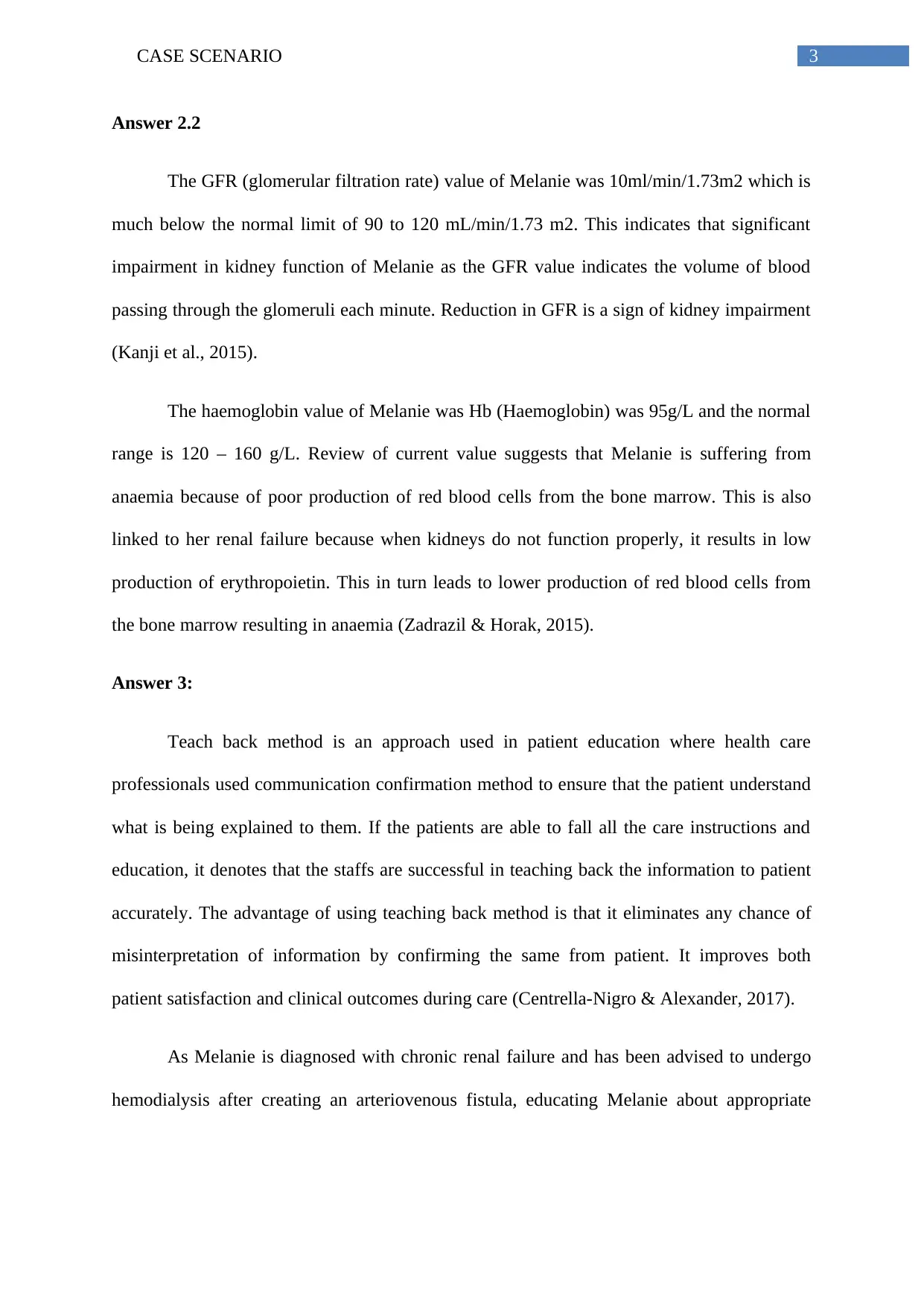
3CASE SCENARIO
Answer 2.2
The GFR (glomerular filtration rate) value of Melanie was 10ml/min/1.73m2 which is
much below the normal limit of 90 to 120 mL/min/1.73 m2. This indicates that significant
impairment in kidney function of Melanie as the GFR value indicates the volume of blood
passing through the glomeruli each minute. Reduction in GFR is a sign of kidney impairment
(Kanji et al., 2015).
The haemoglobin value of Melanie was Hb (Haemoglobin) was 95g/L and the normal
range is 120 – 160 g/L. Review of current value suggests that Melanie is suffering from
anaemia because of poor production of red blood cells from the bone marrow. This is also
linked to her renal failure because when kidneys do not function properly, it results in low
production of erythropoietin. This in turn leads to lower production of red blood cells from
the bone marrow resulting in anaemia (Zadrazil & Horak, 2015).
Answer 3:
Teach back method is an approach used in patient education where health care
professionals used communication confirmation method to ensure that the patient understand
what is being explained to them. If the patients are able to fall all the care instructions and
education, it denotes that the staffs are successful in teaching back the information to patient
accurately. The advantage of using teaching back method is that it eliminates any chance of
misinterpretation of information by confirming the same from patient. It improves both
patient satisfaction and clinical outcomes during care (Centrella-Nigro & Alexander, 2017).
As Melanie is diagnosed with chronic renal failure and has been advised to undergo
hemodialysis after creating an arteriovenous fistula, educating Melanie about appropriate
Answer 2.2
The GFR (glomerular filtration rate) value of Melanie was 10ml/min/1.73m2 which is
much below the normal limit of 90 to 120 mL/min/1.73 m2. This indicates that significant
impairment in kidney function of Melanie as the GFR value indicates the volume of blood
passing through the glomeruli each minute. Reduction in GFR is a sign of kidney impairment
(Kanji et al., 2015).
The haemoglobin value of Melanie was Hb (Haemoglobin) was 95g/L and the normal
range is 120 – 160 g/L. Review of current value suggests that Melanie is suffering from
anaemia because of poor production of red blood cells from the bone marrow. This is also
linked to her renal failure because when kidneys do not function properly, it results in low
production of erythropoietin. This in turn leads to lower production of red blood cells from
the bone marrow resulting in anaemia (Zadrazil & Horak, 2015).
Answer 3:
Teach back method is an approach used in patient education where health care
professionals used communication confirmation method to ensure that the patient understand
what is being explained to them. If the patients are able to fall all the care instructions and
education, it denotes that the staffs are successful in teaching back the information to patient
accurately. The advantage of using teaching back method is that it eliminates any chance of
misinterpretation of information by confirming the same from patient. It improves both
patient satisfaction and clinical outcomes during care (Centrella-Nigro & Alexander, 2017).
As Melanie is diagnosed with chronic renal failure and has been advised to undergo
hemodialysis after creating an arteriovenous fistula, educating Melanie about appropriate
Secure Best Marks with AI Grader
Need help grading? Try our AI Grader for instant feedback on your assignments.
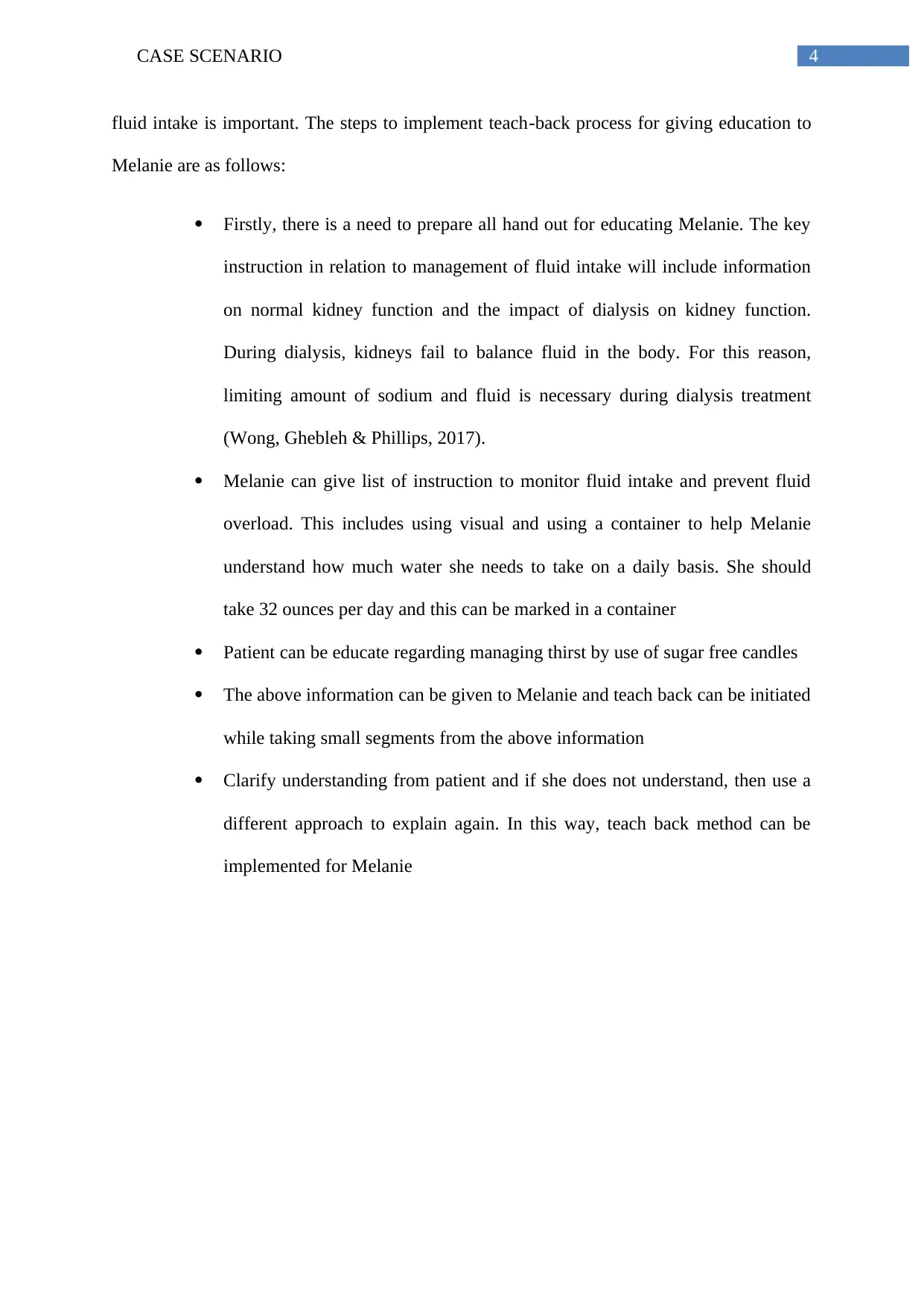
4CASE SCENARIO
fluid intake is important. The steps to implement teach-back process for giving education to
Melanie are as follows:
Firstly, there is a need to prepare all hand out for educating Melanie. The key
instruction in relation to management of fluid intake will include information
on normal kidney function and the impact of dialysis on kidney function.
During dialysis, kidneys fail to balance fluid in the body. For this reason,
limiting amount of sodium and fluid is necessary during dialysis treatment
(Wong, Ghebleh & Phillips, 2017).
Melanie can give list of instruction to monitor fluid intake and prevent fluid
overload. This includes using visual and using a container to help Melanie
understand how much water she needs to take on a daily basis. She should
take 32 ounces per day and this can be marked in a container
Patient can be educate regarding managing thirst by use of sugar free candles
The above information can be given to Melanie and teach back can be initiated
while taking small segments from the above information
Clarify understanding from patient and if she does not understand, then use a
different approach to explain again. In this way, teach back method can be
implemented for Melanie
fluid intake is important. The steps to implement teach-back process for giving education to
Melanie are as follows:
Firstly, there is a need to prepare all hand out for educating Melanie. The key
instruction in relation to management of fluid intake will include information
on normal kidney function and the impact of dialysis on kidney function.
During dialysis, kidneys fail to balance fluid in the body. For this reason,
limiting amount of sodium and fluid is necessary during dialysis treatment
(Wong, Ghebleh & Phillips, 2017).
Melanie can give list of instruction to monitor fluid intake and prevent fluid
overload. This includes using visual and using a container to help Melanie
understand how much water she needs to take on a daily basis. She should
take 32 ounces per day and this can be marked in a container
Patient can be educate regarding managing thirst by use of sugar free candles
The above information can be given to Melanie and teach back can be initiated
while taking small segments from the above information
Clarify understanding from patient and if she does not understand, then use a
different approach to explain again. In this way, teach back method can be
implemented for Melanie
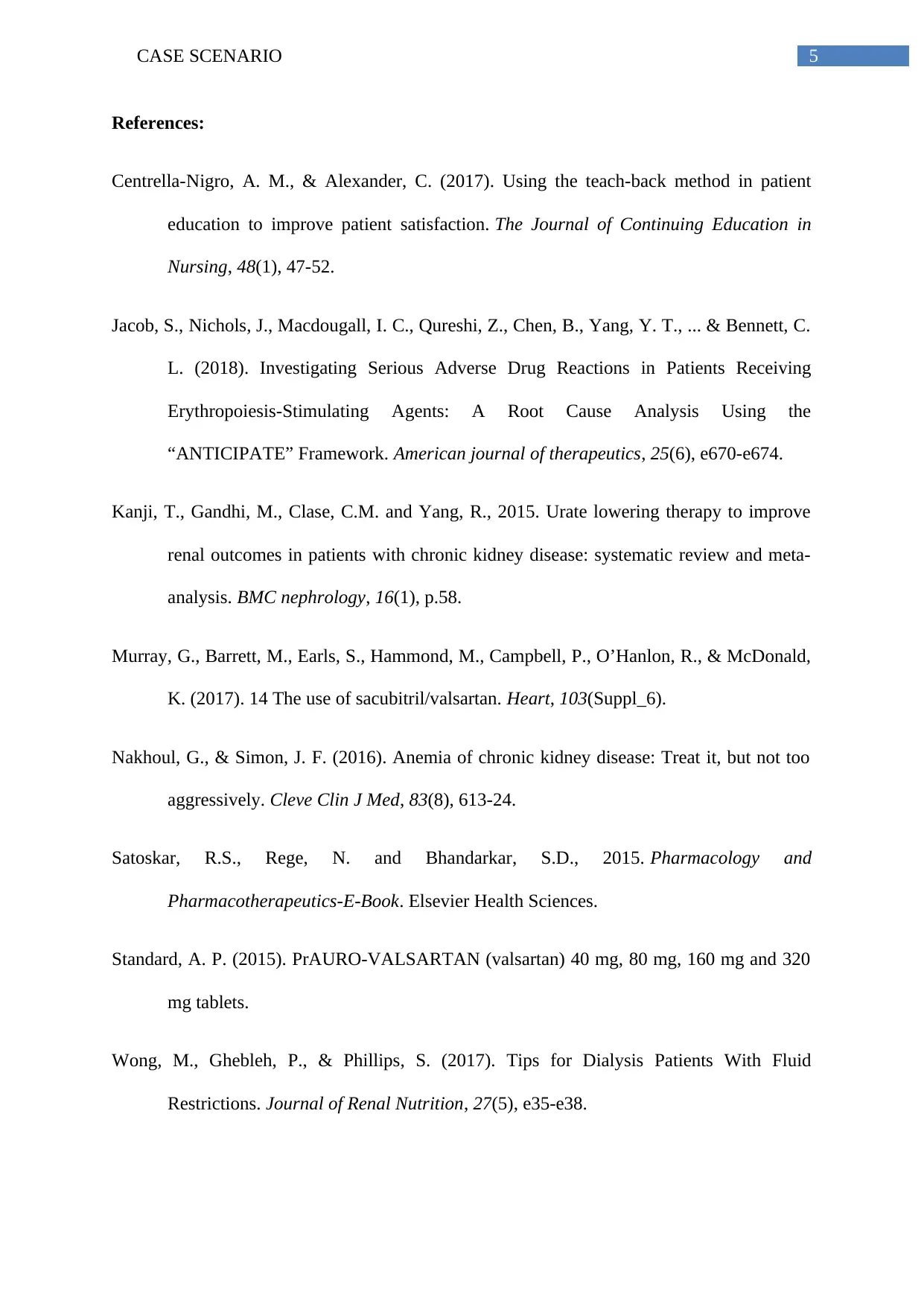
5CASE SCENARIO
References:
Centrella-Nigro, A. M., & Alexander, C. (2017). Using the teach-back method in patient
education to improve patient satisfaction. The Journal of Continuing Education in
Nursing, 48(1), 47-52.
Jacob, S., Nichols, J., Macdougall, I. C., Qureshi, Z., Chen, B., Yang, Y. T., ... & Bennett, C.
L. (2018). Investigating Serious Adverse Drug Reactions in Patients Receiving
Erythropoiesis-Stimulating Agents: A Root Cause Analysis Using the
“ANTICIPATE” Framework. American journal of therapeutics, 25(6), e670-e674.
Kanji, T., Gandhi, M., Clase, C.M. and Yang, R., 2015. Urate lowering therapy to improve
renal outcomes in patients with chronic kidney disease: systematic review and meta-
analysis. BMC nephrology, 16(1), p.58.
Murray, G., Barrett, M., Earls, S., Hammond, M., Campbell, P., O’Hanlon, R., & McDonald,
K. (2017). 14 The use of sacubitril/valsartan. Heart, 103(Suppl_6).
Nakhoul, G., & Simon, J. F. (2016). Anemia of chronic kidney disease: Treat it, but not too
aggressively. Cleve Clin J Med, 83(8), 613-24.
Satoskar, R.S., Rege, N. and Bhandarkar, S.D., 2015. Pharmacology and
Pharmacotherapeutics-E-Book. Elsevier Health Sciences.
Standard, A. P. (2015). PrAURO-VALSARTAN (valsartan) 40 mg, 80 mg, 160 mg and 320
mg tablets.
Wong, M., Ghebleh, P., & Phillips, S. (2017). Tips for Dialysis Patients With Fluid
Restrictions. Journal of Renal Nutrition, 27(5), e35-e38.
References:
Centrella-Nigro, A. M., & Alexander, C. (2017). Using the teach-back method in patient
education to improve patient satisfaction. The Journal of Continuing Education in
Nursing, 48(1), 47-52.
Jacob, S., Nichols, J., Macdougall, I. C., Qureshi, Z., Chen, B., Yang, Y. T., ... & Bennett, C.
L. (2018). Investigating Serious Adverse Drug Reactions in Patients Receiving
Erythropoiesis-Stimulating Agents: A Root Cause Analysis Using the
“ANTICIPATE” Framework. American journal of therapeutics, 25(6), e670-e674.
Kanji, T., Gandhi, M., Clase, C.M. and Yang, R., 2015. Urate lowering therapy to improve
renal outcomes in patients with chronic kidney disease: systematic review and meta-
analysis. BMC nephrology, 16(1), p.58.
Murray, G., Barrett, M., Earls, S., Hammond, M., Campbell, P., O’Hanlon, R., & McDonald,
K. (2017). 14 The use of sacubitril/valsartan. Heart, 103(Suppl_6).
Nakhoul, G., & Simon, J. F. (2016). Anemia of chronic kidney disease: Treat it, but not too
aggressively. Cleve Clin J Med, 83(8), 613-24.
Satoskar, R.S., Rege, N. and Bhandarkar, S.D., 2015. Pharmacology and
Pharmacotherapeutics-E-Book. Elsevier Health Sciences.
Standard, A. P. (2015). PrAURO-VALSARTAN (valsartan) 40 mg, 80 mg, 160 mg and 320
mg tablets.
Wong, M., Ghebleh, P., & Phillips, S. (2017). Tips for Dialysis Patients With Fluid
Restrictions. Journal of Renal Nutrition, 27(5), e35-e38.
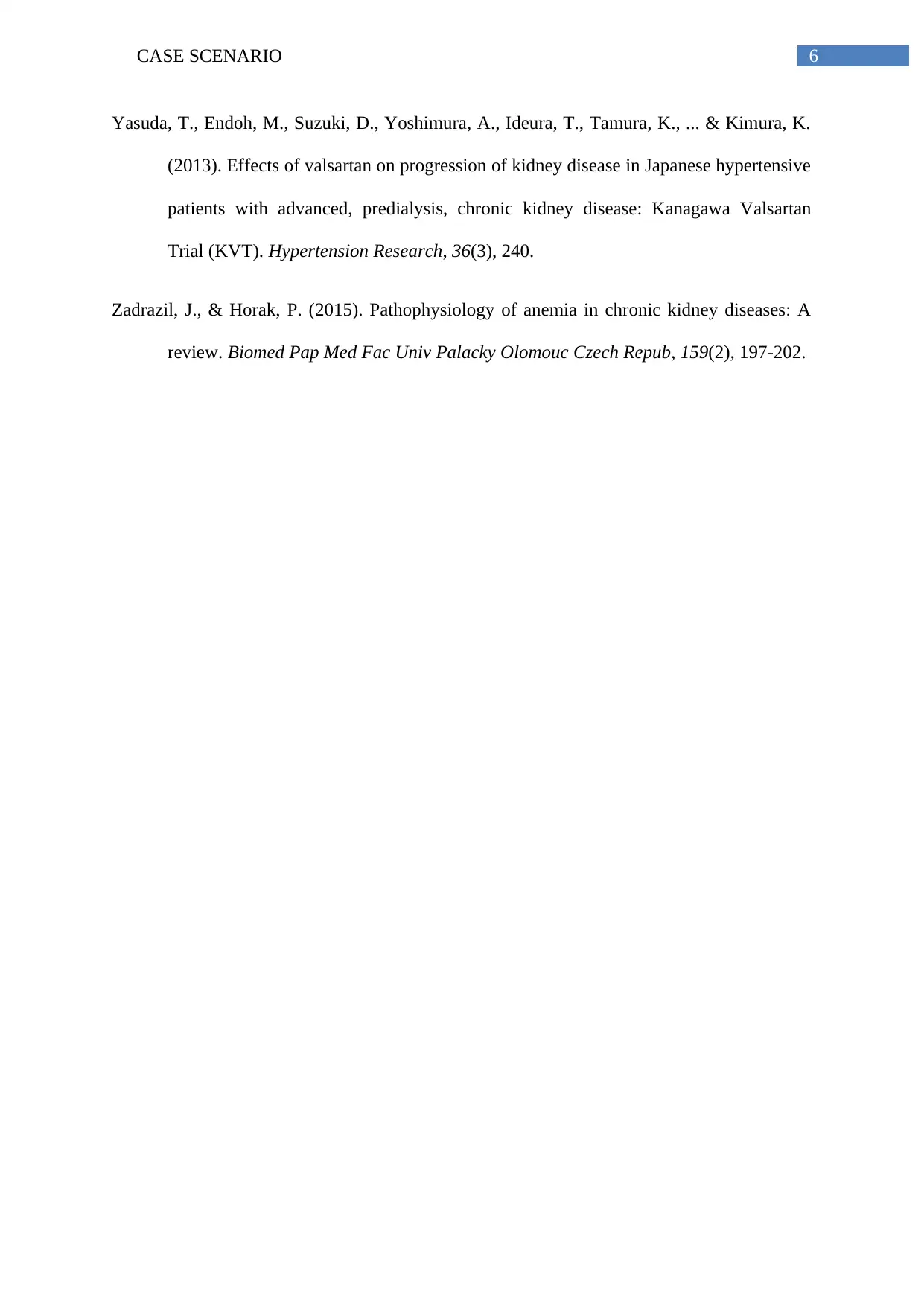
6CASE SCENARIO
Yasuda, T., Endoh, M., Suzuki, D., Yoshimura, A., Ideura, T., Tamura, K., ... & Kimura, K.
(2013). Effects of valsartan on progression of kidney disease in Japanese hypertensive
patients with advanced, predialysis, chronic kidney disease: Kanagawa Valsartan
Trial (KVT). Hypertension Research, 36(3), 240.
Zadrazil, J., & Horak, P. (2015). Pathophysiology of anemia in chronic kidney diseases: A
review. Biomed Pap Med Fac Univ Palacky Olomouc Czech Repub, 159(2), 197-202.
Yasuda, T., Endoh, M., Suzuki, D., Yoshimura, A., Ideura, T., Tamura, K., ... & Kimura, K.
(2013). Effects of valsartan on progression of kidney disease in Japanese hypertensive
patients with advanced, predialysis, chronic kidney disease: Kanagawa Valsartan
Trial (KVT). Hypertension Research, 36(3), 240.
Zadrazil, J., & Horak, P. (2015). Pathophysiology of anemia in chronic kidney diseases: A
review. Biomed Pap Med Fac Univ Palacky Olomouc Czech Repub, 159(2), 197-202.
1 out of 7
Your All-in-One AI-Powered Toolkit for Academic Success.
+13062052269
info@desklib.com
Available 24*7 on WhatsApp / Email
![[object Object]](/_next/static/media/star-bottom.7253800d.svg)
Unlock your academic potential
© 2024 | Zucol Services PVT LTD | All rights reserved.